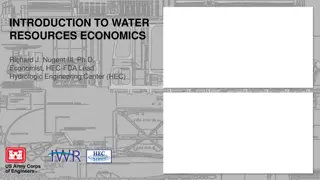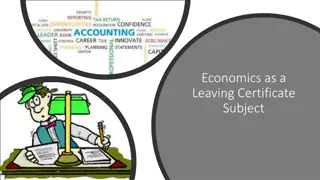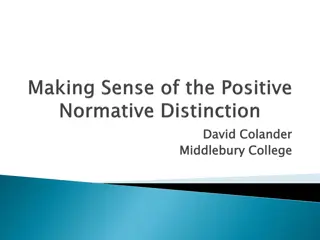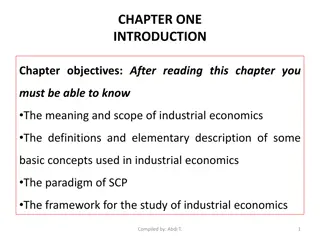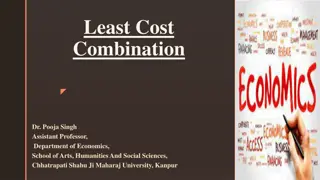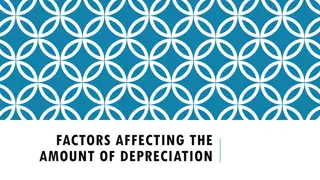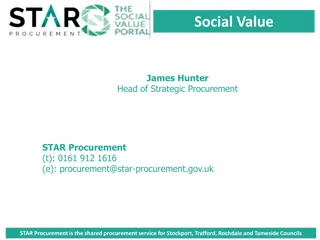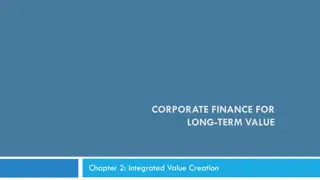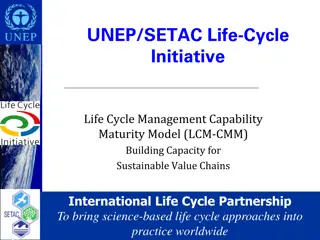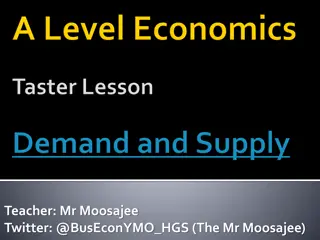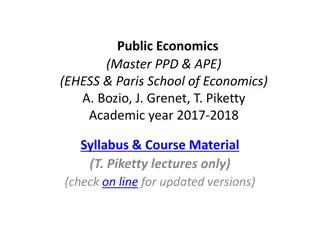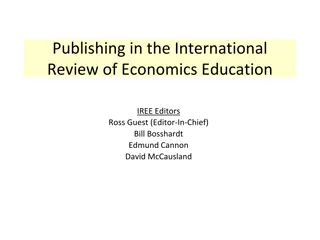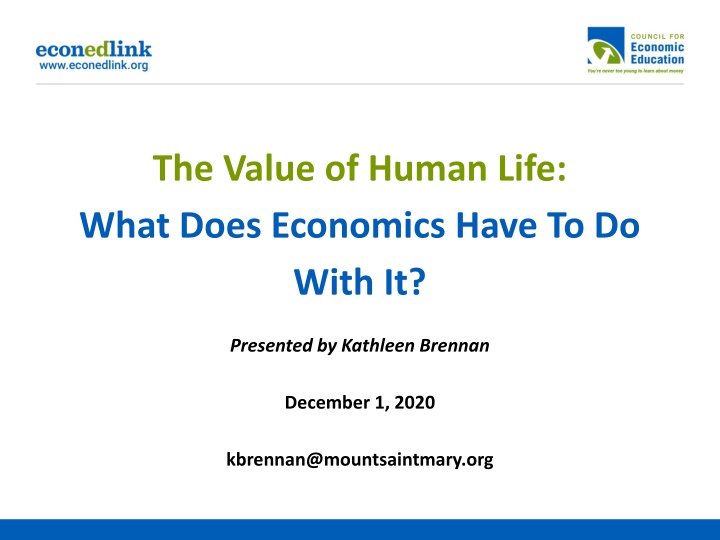
The Value of Human Life: A Look at Economics
Explore the intersection of economics and human life value in this insightful presentation by Kathleen Brennan. Learn about cost-benefit analysis, historical perspectives on regulatory analysis, and examples of regulations. Discover how benefit-cost analysis is conducted, the importance of valuing lives in regulatory policy evaluation, measures of the value of a statistical life (VSL), limitations of VSL, and the application of VSL in the context of Covid-19. Delve into national and state standards related to economics and decision-making.
Download Presentation

Please find below an Image/Link to download the presentation.
The content on the website is provided AS IS for your information and personal use only. It may not be sold, licensed, or shared on other websites without obtaining consent from the author. If you encounter any issues during the download, it is possible that the publisher has removed the file from their server.
You are allowed to download the files provided on this website for personal or commercial use, subject to the condition that they are used lawfully. All files are the property of their respective owners.
The content on the website is provided AS IS for your information and personal use only. It may not be sold, licensed, or shared on other websites without obtaining consent from the author.
E N D
Presentation Transcript
The Value of Human Life: What Does Economics Have To Do With It? Presented by Kathleen Brennan December 1, 2020 kbrennan@mountsaintmary.org
EconEdLink Membership You can now access CEE s professional development webinars directly on EconEdLink.org! To receive these new professional development benefits, become an EconEdLink member. As a member, you will now be able to: Automatically receive a professional development certificate via e-mail within 24 hours after viewing any webinar for a minimum of 45 minutes Register for upcoming webinars with a simple one-click process Easily download presentations, lesson plan materials and activities for each webinar Search and view all webinars at your convenience Save webinars to your EconEdLink dashboard for easy access to the event You may access our new Professional Development page here
Professional Development Certificate To earn your professional development certificate for this webinar, you must: Watch a minimum of 45-minutes and you will automatically receive a professional development certificate via e-mail within 24 hours. Accessing resources: You can now easily download presentations, lesson plan materials, and activities for each webinar from EconEdLink.org/professional-development/
Agenda Cost-benefit analysis Historical perspective of regulatory analysis Examples of regulation
Objectives Understand how benefit cost analysis is done Recognize the need to value lives when evaluating regulatory policy Examine measures of the value of a statistical life (VSL) Understand limitations of VSL Apply VSL in the context of Covid-19
National Standards Standard 1: Scarcity- productive resources are limited; choices must be made Standard 2: Decision Making- effective decision-making requires the comparison of additional costs with additional benefits Standard 16: Role of Government and Market Failure- there is an economic role for government in a market economy whenever the benefits of a government policy outweigh its cost. https://www.councilforeconed.org/wp-content/uploads/2012/03/voluntary-national-content- standards-2010.pdf
State Standards New York Social Studies: Standard 4 Economics- Students understand the nature of scarcity and how nations of the world make choices which involve economic and social costs and benefits. New Jersey Social Studies: N.J.A.C.6 A:8-5.1 (a) 1.iv and v http://www.nysed.gov/curriculum http://www.nysed.gov/curriculum- -instruction instruction https://www.nj.gov/education/cccs/2020/2020%20NJSLS- SS.pdf
Principles of Economics 1. People face tradeoffs. 2. The cost of something is what you give up to get it. 3. Rational people think at the margin. 4. People respond to incentives. 5. Trade can make everyone better off.
Principles of Economics 6. Markets are usually a good way to organize economic activity. 7. Governments can sometimes improve economic outcomes. 8. The standard of living depends on a country s production. 9. Prices rise when a government prints too much money. 10.Society generally faces a short-run tradeoff between inflation and unemployment. Source: Principles of Economics, Gregory Mankiw
Cost-Benefit Analysis (CBA) Good decision-making requires weighing all the costs of an action/choice against all the benefits.
Introduced by French engineer, Jules Dupuit, in the 1840 s Used in 1930 s to evaluate federal water projects in the United States Used to analyze policies affecting transportation, public health, defense, education, and the environment.
There are two main purposes for using cost-benefit analysis: To determine if a policy is sound, justifiable, and feasible by figuring out whether its benefits outweigh its costs. To determine a baseline for comparing alternative policies
1. Identify all costs and benefits 2. Quantify costs/benefits using a monetary value 3. Discount the costs and benefits back to a common time period 4. Assess whether benefits > costs 5. Perform sensitivity analysis
The valuation of many benefits and costs is intuitively obvious, while others, particularly those that deal with the benefit of saving human lives, present problems. How do you put a price tag on saving a human life?
Up until the late 1970s, it was believed that life was too Up until the late 1970 s, it was believed that life was too sacred to value. sacred to value. The Rand Corporation could not evaluate a defense The Rand Corporation could not evaluate a defense program that involved a high rate of casualties since they program that involved a high rate of casualties since they did not know how to value the lives of the serviceman did not know how to value the lives of the serviceman who would be killed. who would be killed.
- The cost of a bomb, parachute, or training program was easy. - What was the value of the crew who would potentially be lost?
Benefit-cost analysis for all major rules was specifically required and mandated selecting the regulatory option that minimizes net costs and maximizes net benefits, unless otherwise precluded from doing so by applicable law. See: Executive Order 12291 See: Executive Order 12291
Cost-benefit analysis is required for any major regulation that costs more than $100 million per year.
Benefits Costs Reduced damage to exposed materials Increased cost of firm s product Diminished health risks to citizens Potential plant closures Laid off workers Improved visibility Decrease planned investment Increased jobs for those manufacturing pollution control equipment
Assume: a pollutant cause excess mortality of 1,000 deaths per year in the population at risk Reducing emissions by 50% would cost $5 million and excess mortality would be decreased to 500 deaths per year. Reducing emissions by 100% would cost $500 million and would reduce excess mortality to zero.
Level of Control (percentage) Cost of control (dollars) Marginal Cost Excess Mortality (deaths per year) Marginal Benefit No control 0 - 1,000 - 50 $5,000,000 $5,000,000 500 500 lives saved 100 $500,000,000 $495,000,000 0 500 lives saved
Present value of economic loss: - lost earnings - services - medical expenses Approximately: $300,000 (1982 $) $800,000 (today)
Level of Control (percentag e) Cost of control (dollars) Marginal Cost Excess Mortality (deaths per year) Marginal Benefit Marginal Benefit ($300,000 per life) No control 0 - 1,000 - - 50 $5,000,000 $5,000,000 500 500 lives saved $150,000,000 100 $500,000,0 00 $495,000,000 0 500 lives saved $150,000,000 Marginal Benefits > Marginal Costs at 50% control, but not at 100% control
Benefits Costs 4750 lives @ $300,000 per life Labeling, ink, etc. $1.4 billion $2.6 billion Benefits < Costs
1968- Thomas Schelling, The Life You Save May Be your Own 1978- Warren Prunella (Canisius College), Flammability Standards 1981- Kip Viscusi (Vanderbilt), Risk and Uncertainty 2020- Tom Kniesner (Ohio State), Health Economics 2020- Lisa Robinson (Harvard), Center for Decision Science
Labor Market Studies Labor Market Studies Compensating wage differentials to accept higher risk of death Contingent Valuation Studies Contingent Valuation Studies Ask people directly would they would pay for a change in the risk of death Averting Behavior Studies Averting Behavior Studies Use data on seatbelt use, smoke detector and bike helmet purchases
Concept of a Statistical Life Reduce the risk of death by 1/1000 for each of 1,000 people saves one statistical life How much would individuals be willing to pay? If each of 10,0000 people are willing to pay $1,000 for a 1/1000 risk reduction The value of a statistical life is 10,000 X $1,000 = $10 million
One estimate doesnt necessarily fit all: How does age affect VSL? Does wealth or income affect the estimates? Does morbidity prior to death affect VSL?
Cutler and Summers: National Bureau of Economic Research- 11/16/20
Cutler and Summers, National Bureau of Economic Research- 11/16/20
1. What trade-offs do we face with Covid-19? 2. Are we able to identify and estimate all the costs? 3. Are rational people thinking at the margin? 7. Can the government improve the outcome?
References https://www.marketplace.org/2020/04/23/how-much-is-a-human-life-worth/ https://www.marketplace.org/2019/03/20/how-value-life/ https://www.nber.org/news/economic-cost-covid-19 https://www.theregreview.org/2020/08/05/robinson-covid-19-uncertainties- value-statistical-life/ https://www.benefitcostanalysis.org/covid-19_benefit_cost_analysis.php https://www.nytimes.com/2020/05/11/upshot/virus-price-human-life.html https://www.wired.com/story/how-much-is-human-life-worth-in-dollars/ https://www.theregreview.org/2020/08/05/robinson-covid-19-uncertainties- value-statistical-life/
CEE Affiliates https://www.councilforeconed.org/resources/local-affiliates/


